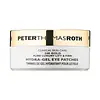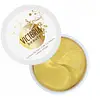What's inside
What's inside
 Key Ingredients
Key Ingredients

 Benefits
Benefits

 Concerns
Concerns

 Ingredients Side-by-side
Ingredients Side-by-side

Water
Skin ConditioningGlycerin
HumectantCarrageenan
Butylene Glycol
HumectantCeratonia Siliqua Gum
EmollientColloidal Gold
AntimicrobialSodium Hyaluronate
HumectantHydrolyzed Collagen
EmollientCaffeine
Skin ConditioningNiacinamide
SmoothingAloe Barbadensis Leaf Juice Powder
Skin ConditioningTocopheryl Acetate
AntioxidantAllantoin
Skin ConditioningJania Rubens Extract
Skin ConditioningAdenosine
Skin ConditioningLavandula Angustifolia Oil
MaskingRicinus Communis Seed Oil
MaskingCalcium Lactate
AstringentXanthan Gum
EmulsifyingDisodium EDTA
PEG-60 Hydrogenated Castor Oil
EmulsifyingSynthetic Fluorphlogopite
Mica
Cosmetic ColorantTin Oxide
AbrasiveChlorphenesin
AntimicrobialPhenoxyethanol
PreservativeCI 77480
Cosmetic ColorantCI 77491
Cosmetic ColorantCI 77891
Cosmetic ColorantWater, Glycerin, Carrageenan, Butylene Glycol, Ceratonia Siliqua Gum, Colloidal Gold, Sodium Hyaluronate, Hydrolyzed Collagen, Caffeine, Niacinamide, Aloe Barbadensis Leaf Juice Powder, Tocopheryl Acetate, Allantoin, Jania Rubens Extract, Adenosine, Lavandula Angustifolia Oil, Ricinus Communis Seed Oil, Calcium Lactate, Xanthan Gum, Disodium EDTA, PEG-60 Hydrogenated Castor Oil, Synthetic Fluorphlogopite, Mica, Tin Oxide, Chlorphenesin, Phenoxyethanol, CI 77480, CI 77491, CI 77891
Water
Skin ConditioningGlycerin
HumectantPropylene Glycol
HumectantChondrus Crispus Powder
AbrasiveTrehalose
HumectantGlycereth-26
HumectantGlycosaminoglycans
EmollientHydrolyzed Collagen
EmollientPhenoxyethanol
PreservativeXanthan Gum
EmulsifyingButylene Glycol
HumectantPortulaca Oleracea Extract
Skin ConditioningGlyceryl Polymethacrylate
Pvm/Ma Copolymer
Emulsion StabilisingHydrolyzed Sclerotium Gum
HumectantSaccharide Isomerate
HumectantHydroxyethylcellulose
Emulsion StabilisingCamellia Sinensis Leaf Extract
AntimicrobialCyclodextrin
AbsorbentCaffeine
Skin ConditioningAllantoin
Skin ConditioningPEG-40 Hydrogenated Castor Oil
EmulsifyingSodium Hyaluronate
HumectantParfum
MaskingMica
Cosmetic ColorantCI 77891
Cosmetic ColorantCI 77491
Cosmetic ColorantWater, Glycerin, Propylene Glycol, Chondrus Crispus Powder, Trehalose, Glycereth-26, Glycosaminoglycans, Hydrolyzed Collagen, Phenoxyethanol, Xanthan Gum, Butylene Glycol, Portulaca Oleracea Extract, Glyceryl Polymethacrylate, Pvm/Ma Copolymer, Hydrolyzed Sclerotium Gum, Saccharide Isomerate, Hydroxyethylcellulose, Camellia Sinensis Leaf Extract, Cyclodextrin, Caffeine, Allantoin, PEG-40 Hydrogenated Castor Oil, Sodium Hyaluronate, Parfum, Mica, CI 77891, CI 77491
Ingredients Explained
These ingredients are found in both products.
Ingredients higher up in an ingredient list are typically present in a larger amount.
Allantoin is a soothing ingredient known for its protective and moisturizingg properties. Because of this, it is often added to products with strong active ingredients.
Studies show higher concentrations of this ingredient can promote wound healing.
Though it can be derived from the comfrey plant, allantoin is produced synthetically for cosmetic products to ensure purity.
Learn more about AllantoinButylene Glycol (or BG) is used within cosmetic products for a few different reasons:
Overall, Butylene Glycol is a safe and well-rounded ingredient that works well with other ingredients.
Though this ingredient works well with most skin types, some people with sensitive skin may experience a reaction such as allergic rashes, closed comedones, or itchiness.
Learn more about Butylene GlycolCaffeine is most associated with coffee, tea, and cacao. In skincare, it helps with calming inflammation and is rich in antioxidants.
While caffeine is used to treat cellulite and and dark circles, further studies are needed to prove this. It has been believed to help with these skin conditions due to its ability to dilate blood vessels and increase blood flow.
Some studies are looking into caffeine's ability to protect against UV rays.
Learn more about CaffeineCi 77491 is also hydrated iron III oxide. It's sole purpose is to give a red/pink hue to products.
Iron III oxides are classified as inorganic chemicals for coloring.
Synthetically created Ci 77491 is considered safer than those naturally found. This is because the synthetically created version may contain less impurities. Iron oxides are generally non-toxic and non-allergenic.
Learn more about CI 77491Ci 77891 is a white pigment from Titanium dioxide. It is naturally found in minerals such as rutile and ilmenite.
It's main function is to add a white color to cosmetics. It can also be mixed with other colors to create different shades.
Ci 77891 is commonly found in sunscreens due to its ability to block UV rays.
Learn more about CI 77891Glycerin is already naturally found in your skin. It helps moisturize and protect your skin.
A study from 2016 found glycerin to be more effective as a humectant than AHAs and hyaluronic acid.
As a humectant, it helps the skin stay hydrated by pulling moisture to your skin. The low molecular weight of glycerin allows it to pull moisture into the deeper layers of your skin.
Hydrated skin improves your skin barrier; Your skin barrier helps protect against irritants and bacteria.
Glycerin has also been found to have antimicrobial and antiviral properties. Due to these properties, glycerin is often used in wound and burn treatments.
In cosmetics, glycerin is usually derived from plants such as soybean or palm. However, it can also be sourced from animals, such as tallow or animal fat.
This ingredient is organic, colorless, odorless, and non-toxic.
Glycerin is the name for this ingredient in American English. British English uses Glycerol/Glycerine.
Learn more about GlycerinHydrolyzed collagen has a misleading name because it is actually a mixture of various proteins/peptides. This ingredient has skin hydrating properties.
Collagen is the most abundant type of structural protein found in your body. In your skin, it is responsible for keeping it firm and youthful.
Hydrolyzed Collagen is created by breaking up proteins into smaller peptide bonds. These peptides act as humectants and emollients.
Humectants are great at holding onto water, keeping skin hydrated. Emollients create a thin barrier on the skin to prevent moisture from escaping.
There is ongoing debate about whether hydrolyzed collagen works because it increases skin hydration. Skin hydration is also linked to elasticity and the appearance of wrinkles.
Collagen or peptide ingredients can be used in the morning or night. They will not increase sun sensitivity, but you should always wear sunscreen during the day.
According to a manufacturer, this ingredient is a great hair conditioner as well.
This ingredient can be extracted from different sources, including:
Vegan collagen is derived from yeast, bacteria, or plant sources. Vegan collagen would go by a different INCI name, such as hydrolyzed soy protein.
The results are varied.
A study from 2021 found hydrolyzed collagen increased elasticity and improved wrinkles in 1,125 participants between age 20 and 70. Another study found increased skin thickness in participants between the ages of 45 to 59.
However, It is difficult to prove that oral collagen will end up working on your skin. Many of the studies using hydrolyzed collagen also add several vitamins and nutrients into the test mixture as well.
Further studies are needed at this time.
Learn more about Hydrolyzed CollagenMica is a naturally occurring mineral used to add shimmer and color in cosmetics. It can also help improve the texture of a product or give it an opaque, white/silver color.
Serecite is the name for very fine but ragged grains of mica.
This ingredient is often coated with metal oxides like titanium dioxide. Trace amounts of heavy metals may be found in mica, but these metals are not harmful in our personal products.
Mica has been used since prehistoric times throughout the world. Ancient Egyptian, Indian, Greek, Roman, Aztec, and Chinese civilizations have used mica.
Learn more about MicaPhenoxyethanol is a preservative that has germicide, antimicrobial, and aromatic properties. Studies show that phenoxyethanol can prevent microbial growth. By itself, it has a scent that is similar to that of a rose.
It's often used in formulations along with Caprylyl Glycol to preserve the shelf life of products.
Sodium Hyaluronate is hyaluronic acid's salt form. It is commonly derived from the sodium salt of hyaluronic acid.
Like hyaluronic acid, it is great at holding water and acts as a humectant. This makes it a great skin hydrating ingredient.
Sodium Hyaluronate is naturally occurring in our bodies and is mostly found in eye fluid and joints.
These are some other common types of Hyaluronic Acid:
Learn more about Sodium HyaluronateWater. It's the most common cosmetic ingredient of all. You'll usually see it at the top of ingredient lists, meaning that it makes up the largest part of the product.
So why is it so popular? Water most often acts as a solvent - this means that it helps dissolve other ingredients into the formulation.
You'll also recognize water as that liquid we all need to stay alive. If you see this, drink a glass of water. Stay hydrated!
Learn more about WaterXanthan gum is used as a stabilizer and thickener within cosmetic products. It helps give products a sticky, thick feeling - preventing them from being too runny.
On the technical side of things, xanthan gum is a polysaccharide - a combination consisting of multiple sugar molecules bonded together.
Xanthan gum is a pretty common and great ingredient. It is a natural, non-toxic, non-irritating ingredient that is also commonly used in food products.
Learn more about Xanthan Gum